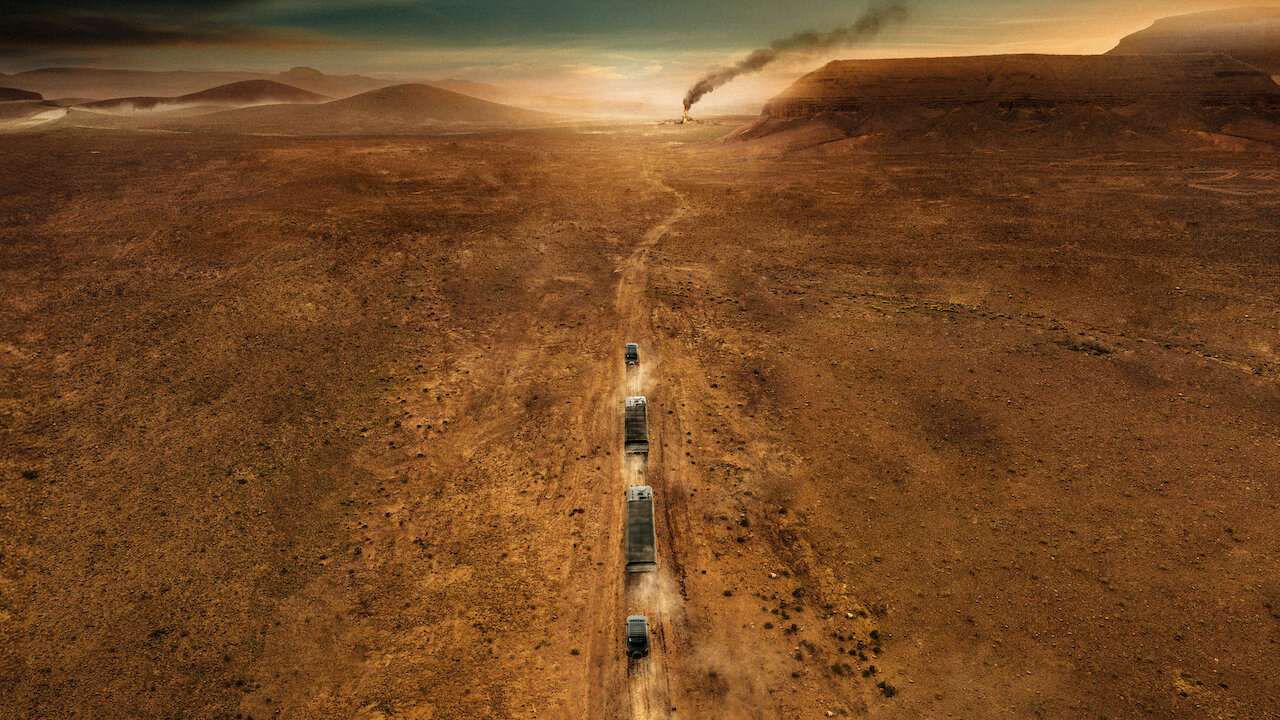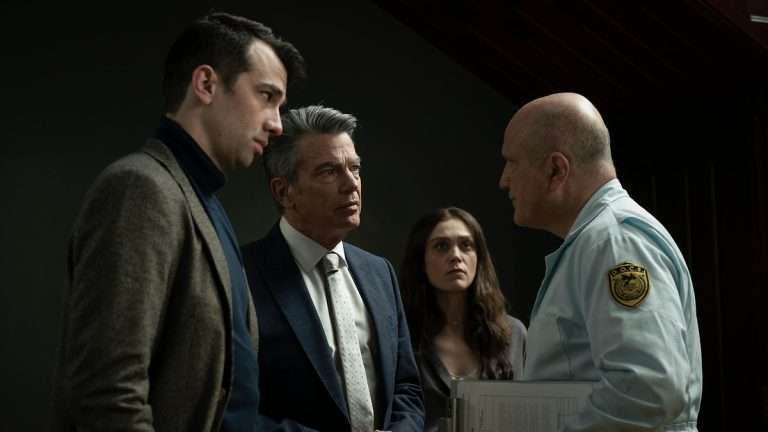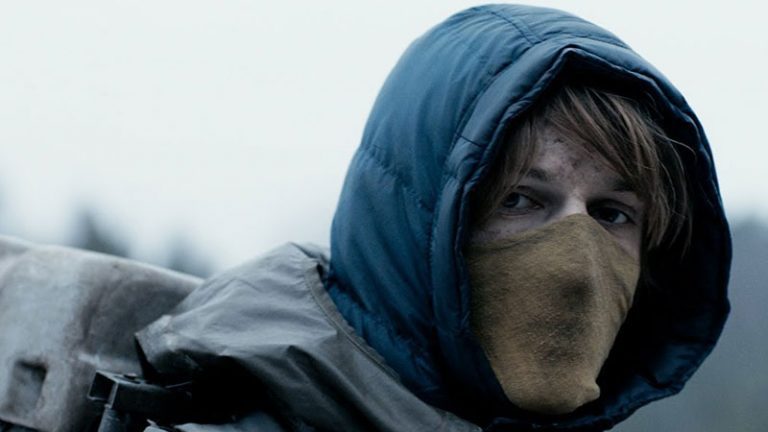Here’s a piece of unsolicited advice to movie directors interested in remaking classics of a bygone era: unless you can successfully replicate the period in which the film was set or the conflicts that could arise from geographical and geopolitical constraints, it is hard to differentiate your modern-day remake from a straight-to-video-action spectacle. The 2024 remake of Henri-Georges Clouzot’s 1953 nihilistic action film “The Wages of Fear,” an adaptation of the Georges Arnaud novel, has an uphill battle. It is doubly difficult considering its comparison is not just with the original but with its illustrious first remake, “Sorcerer” (1977), itself a nihilistic masterpiece with all the cynicism that the decade of the 70s could muster with director William Friedkin’s process-oriented, practical stunt work-laden visceral mayhem.
The Wages of Fear (2024) Movie Summary and Plot Synopsis
Justin Leclercq’s 2024 actioner opens in a desert near an oil pipeline. We see one of the workers in that empty stretch look up upon hearing gunshots. He sees a jeep, with the familiar symbol of an NGO emblazoned on its side, being chased by a presumably Arabian militia. The man gets up in his car and helps the NGO jeep from being stuck on the rocky terrain by pushing it over, and then escorts it to the refugee camp that is guarded by mercenaries. As the two jeeps drive inside the refugee camp, we see the soldiers shooting back against the Arab militia truck as it slows down and turns back.
We realize that in this world in which director Leclercq is not going to emphatically state geographical locations but could very well be Algeria, the refugee camp is centered around an oil well. The NGO, led by Clara (Ana Giradout), is having a physical relationship with Fred (Franck Gastambide), the man who rescued her. Alex is the lead we are ostensibly following. In a flashback taking place nine months ago, we are again dropped into an unnamed city on the verge of tearing itself apart from a coup that had already led to the president fleeing the country.
Fred, we learn, is part of a private security team and is currently responsible for aiding one of his rich clients in fleeing the country. We notice that the client is being visited by the CEO of one of those oil wells. She is escorted by a mercenary like Fred, by the name of Gauthier (Birol Tarkan Yildiz), with whom Fred is also familiar. As the two of them converse outside the building, they are attacked by a group of protesters. They make quick work of those protesters, but Fred is unable to forget what he had seen when he arrived to fetch his client—a safe filled with unregulated cash. Hatching a plan, he tries to convince his brother Alex (Alban Lenoir), a demolitions expert, to aid in one last job: cracking open the safe.
Alex begrudgingly agrees and enters the building while the whole city is distracted, but Fred keeps guard outside. As Alex tries to blast open the safe with an explosive set to a timer, his luck runs out. During a routine check of the evacuated manors, the authorities come across Alex trying to break open the safe. Alex is too late to stop the timer from running out, and it blasts the door open, killing one of the cops in the process. Fred has been unable to warn Alex to escape in time, and he watches as his brother is taken away to prison.
Nine months later, we find Fred working as an oil rig man near the oil well, where a refugee camp has also been set up. Alex’s wife and daughter also stay there, under Fred’s care, with Alex’s wife teaching the kids of that village. Fred plans to earn enough money to take Alex’s wife and child out of the village, but his plan is interrupted by the oil well exploding.
However, it hides the bigger problem, which representatives of the American oil company had figured out and had arranged for a million dollars for the security team to solve. There is a second pocket behind the oil pocket that caused the fire due to gas leakage. If the fire spreads to the second pocket, the resultant explosion could affect not only the oil well but also the village and the surrounding countryside. The plan to stop it is to hire a security team, transport 100 kilograms of nitroglycerin, and incite an explosion, which would total that area before the fire spreads into the second pocket. They have 24 hours to solve this issue.
The chief of the security team takes Gauthier’s advice and hires Fred for the role, giving him an offer he couldn’t refuse: if he completes the mission, the company would fund Alex’s family’s evacuation from the village. The catch is hiring Alex for his expertise in bombing, and that would entail taking him out of prison on a “loan.” Meanwhile, Clara, the head of the NGO, and her assistant, Djibril, are hired as guides through the route because they conduct vaccine runs all the time.
Taking Alex out of prison is child’s play for Gauthier and his team; the reunion between the two brothers is less so, leading to a scuffle between the two brothers that would only be broken by Clara and the seriousness of the job at hand. Unrefined nitroglycerin is dangerous if not handled correctly, as evidenced by Alex throwing a drop of the liquid a few feet away and the liquid exploding on impact. The plan is to drive two trucks, each driven by one of the brothers, escorted by Gauthier and his team, and guided by Clara. The trucks would be filled with Nitroglycerin that would be forcefully taken from a solar panel factory.
The careful packaging of the Nitroglycerin, using crates reinforced together to the walls of the truck by cables holding it in place, goes off without a hitch, but as the two brothers drive the trucks out, one of the security guards who had been tied up frees himself and attacks one of the mercenaries guarding the factory. In the middle of that scuffle, one of the canisters containing nitroglycerin falls to the ground, destroying the factory.
The trip through the treacherous terrain is beset with different troubles. On the one hand, Gauthier’s attitude rankles Clara, who, in the middle of their trip, walks out of her car and joins Fred in his truck. On the other hand, they are stopped by a militia roadblock, who refuse to believe the trucks contain medicines. As the rebels, armed with guns, surround the convoy, the leader forcefully walks towards the truck to check its cargo, and Djibril tries to convince the rebels that they are a peaceful crew. None of it goes to plan, as the rebels attack the convoy, killing Djibril, and the crew fires back. They only manage to escape by cornering the militia towards a rocky road, whereby Gauthier, through his expert marksmanship, manages to kill the militia by toppling their cars.

The second hurdle they come across is when one of the mercenaries drives their unsuspecting ATV through an active minefield. Both Alex and Fred bypass this issue by utilizing chains. The two brothers connect the chains into a long steel net and drag it through the dusty road, managing to hit one of the mines. In the process, Fred steps onto one of the mines, which Alex barely manages to extricate him from by pulling him and jumping back simultaneously, only for the mine to not activate. In the middle of all these hullabaloos, they are attacked by a single sniper camouflaged within the terrain of the balding mountains. Gauthier, his comrade, and Fred manage to smoke the sniper out and kill her, but unbeknownst to him, Gauthier’s comrade steps on a mine and kills himself.
The crew has now dwindled to four, and so they split up: one truck would take the route going north, while the other would bypass by going west. One of the trucks carries Gauthier and Fred while Alex and Clara follow them going north. Here is where the movie truly becomes a homage to “Wages of Fear,” whereby the obstacle that Fred’s truck comes across is the oil leak that has effectively become a river. They manage to drive the truck through, but at the last moment, Gauthier betrays Fred for a larger share of the million dollars and shoots Fred, leaving him dead.
Meanwhile, Alex and Clara come across the other famous set piece from “The Wages of Fear”—the boulder trapping the hilly road. Alex manages to break through the obstacle by sucking in a few drops of nitroglycerin, inserting it inside the rock, and then pushing a stick through the hole. The resulting friction causes the boulder to explode, clearing the road of debris.
When they finally reach the oil lake, they notice the tire tracks of the other truck have already crossed through the lake, giving them confidence. They unfortunately witness the other truck, driven by Gauthier, being driven off the treacherous mountain road due to the faulty gear that had been hinted at since the beginning of the journey. Alex and Clara are heartbroken, having thought that Fred had been in the truck, only to be called forth by a villager. The villager had managed to drag the wounded Fred out of the lake.
As Clara and Alex drive the truck, with a wounded Fred in the middle of them, barely hanging on to dear life, the truck is attacked by another militia vehicle. The road is treacherous, bullets hitting the truck would risk hitting the nitroglycerin, blowing the truck and everyone in it sky high. Clara, in an act of daredevilry, climbs to the top of the truck and drops to the back. There, she unhooks one of the nitroglycerin canisters and throws them at the vehicle, following them. It is on her third try that one of the canisters hits the target, destroying the vehicle.
The Wages of Fear (2024) Ending Explained:
What Happens to Fred in the End?
Meanwhile, time is running out. The fire would be reaching the second pocket within an hour, and Anne Marchand, the leader of the security team of the American oil company, had kidnapped Alex’s wife and daughter. The reason was that her team had been unable to send the drilling team on time, which would bury the nitroglycerin and induce a controlled explosion. Thus, she had to resort to unsavory measures, namely, forcing the brothers to drive the truck into the oil well to save his family.
Alex, currently held literally under gunpoint, is forced into a dilemma. Unfortunately for him, he wouldn’t have to decide as the injured Fred shoots Anne and her security guard, holding Alex’s family hostage. Rescuing them and allowing Alex the opportunity to reunite with his family and resume his life, Fred says goodbye to Clara and drives the truck into the oil well, destroying the area and preventing the catastrophe from ever occurring. As the villagers rejoice in celebration due to Fred’s heroic sacrifice, Alex notices a helicopter landing, presumably to escort him and his family out of the village, as the film ends.
The Wages of Fear (2024) Movie Review:
It is certainly a choice to take what is essentially an existential, nihilistic text, an anti-capitalist story, and just strip it of all of its nuances. It is a choice to remake a classic film into a direct-to-streaming disposable fodder with the same color palette, the same amount of dodgy visual effects, and a similar utilization of editing. If there are positives that could be attributed to “The Wages of Fear,” it would be the cinematography, which is also a result of having been shot primarily in location. The other key positive would be the action sequences, the chase scenes in particular, which manage to look coherent on account of Leclercq’s handle on making competent choices in terms of designing action choreography.
Everything else in the movie feels strangely inert. The directorial choice to not highlight the geographical location could be traced back to the source material itself, where the primary conflict would be the class divide and how capitalism’s tendrils affect all of humanity’s strata. However, the choice to deliberately set two of the key characters’ backstories in a time of unrest and not point to any specific geopolitical and, consequently, geographical conflicts makes the movie seem strangely nebulous. The antagonists, as a result, feel ancillary, which is a major problem in this update.
Understandably, Leclercq would choose to highlight the conflicts faced by the crew in a much more visceral and fast-paced manner. Thus, frontloading the film with chase sequences is not one of the worst ideas. However, the nebulous identities of the antagonists (are they rebels or militia?) only serve to complicate and further muddy the waters. It also takes away from the anti-capitalist and anti-establishment sentiment that had been a staple of the original; by choosing to focus on an emotional connection between two brothers as well as introducing a female doctor as a love interest,
“The Wages of Fear” robs itself of the incisive commentary of brotherhood amidst dire circumstances, as well as the flimsy nature of said brotherhood when united under the common umbrella of capitalism. As a result, the movie feels strangely devoid of stakes, so burdened it is with the tropes of a typical actioner. As a result, even the familiar set pieces, serving as homages to the original, feel ancillary and half-baked. In the original, those set pieces were designed to elicit suspense as well as reveal the capabilities of all these characters under unimaginable pressure. Here, those sequences only serve to further the plot.
Clouzot’s film was a character study; Friedkin’s was a character study under pressure, straining the limits of realism-tinged process-oriented filmmaking. Leclercq’s film feels like an AI-paraphrased version of the Georges Arnaud novel, devoid of all thematic nuances and just coasting on a thrill ride. It is disposable fodder, but it isn’t “The Wages of Fear,” and it definitely isn’t “Sorcerer.”









